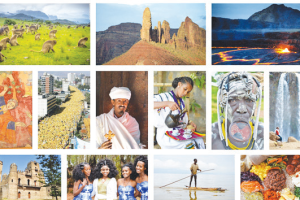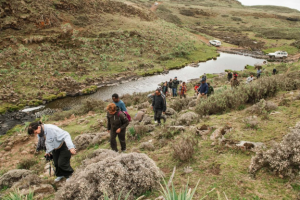
BY TEWODROS KASSA
Contributing one’s share to the improvement of natural and cultural heritages is the habitual action and the social responsibility of every individual. Introducing such model conservation works would encourage others to follow the suit set of Menz Guassa Community Conservation.
Apart from eye-catching scenes, one will stand a chance of closely observing Ethiopian endemic animals—a Red Fox and Gelada Baboon— gamboling over the steeply mountain and precipice of Menz. The milieu is adorn with springs that gush out from big meandering, small brooks and zigzagging roads that snakes around the hills that afford a vantage point to feast one’s eyes on the greenery; the plateaus boast of at the feet of the hills.
The area reserved for conservation in Menz Guassa has an Afro-alpine climatic condition. The area, found in Menz Gera Midir Woreda, abounds in lash grasses locally called Guassa.
This meadow, which supports the growth of such tall grass species, stretches over 100 square kilometer. People’s tenderness to the area dates back to the 17th century. In the northern direction, it is located 250 kilometers away from the capital Addis. And it sprawls at a spot, which is 20 km from the district town; Mehal Meda.
Residents of the locality utilize the Guassa grass to build huts having thatch roofs, making ropes, beautifying their homes strewing it all over floors and to make brooms.
The community assigned watchman to see vigilantly the safety of the conserved park staying there without succumbing to the cold weather of the area.
One of the watchmen Haylegnaw Shewandagne told this writer that every resident of the area has a responsibility to watch and control the surrounding place and arrest any illegal activity that could damage the conserved area. There were no so illegal activities that negatively impact the park in the past.
However, the destructive group led by the terrorist Tigray Peoples’ Liberation Front (TPLF) had caused a massive destruction on the conserved areas and the endemic animals residing in the park. Thanks to God; currently the area is recovering from the destructions acts of the terrorist group, he added.
“Long years ago, residents of the area have reached on a consensus to expose any destructive activities against the park. Our forefathers have come up with their own cultural system of administering and ensuring the safety of the park against illegal humans’ interventions. In fact, this is an unwritten rule of the community. Happily inheriting the culture of conserving the area and wild animals therein we strive to ensure the longevity and betterment of this place. Thus, we have developed the culture of exposing evildoers who may try to wreak havoc on nature”.
He emphasized that parallel to tending our farming work. we have a duty of securing the conserved area from any damage. Currently, the ecology of the park is showing a turn for the better. It is becoming home to diversified mammals, birds and a wide-array of plant species.
The society there is careful in sparing the Guassa grasses from animals’ encroachment. Such commendable environment stewardship is not a limited responsibility of elders, farmers, the park guardians or the culture and tourism office; but demands the concerted efforts of all.
Human beings are responsible for the defacing action of mother nature, annihilating nature while hunting wild animals, felling down trees and militating against other natural resource to fulfill their demands.
Contrary to this, human beings’ environment-smart approach towards mother nature has become discernible in different parts of our planet; earth.
Having a local code and principle of penalty against the destructive activities of some individuals has proved reinforcement to environmental protection awareness in Menz.
The environment stewardship culture adopted by forefathers to keep the Menz Guassa Community Conservation area is still doable. This noble tradition must be promoted and strengthened in the future too. The young generation must also be taught to pass down this tradition to their children and grandchildren.
If you by any chance set your feet on the area you would observe the two Ethiopian endemic animals – Red Fox and Gelada Baboon— together.
The climatic condition of the area is windy and cold. A year-long humidity characterizes it. Moreover, the area conserves diverse highland and temperate flora and fauna.
In sum, the Menz Guassa Community Conservation system is one of the oldest known common natural resource management systems in Africa. While the society watches up the criminal, no one could find a way to harm nature or endanger the lives of animals which are the other attractions of the place. Observably, the people of Menz hugely made commendable activities as evidenced by the fulfilment of their social responsibility in taking care a forest and the creatures there in.
The experience of Menz Guassa community conservation is worth emulating for others having similar geographical locations of endemic animals and vegetation.It is important to note that it is daunting if not impossible to restore nature back once it suffered loss.
Today, the Menz Guassa Community Conservation has become guardian of endemic animals. Enhancing those traditional conservation tasks and galvanizing the public through further awareness creation and experience sharing programs is a plus in the efforts of tackling global climatic related challenges and creating sustainable ecosystem for the endemic animals.
The Ethiopian Herald April 15/2022





